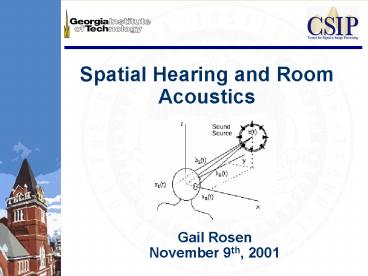Spatial Hearing and Room Acoustics - PowerPoint PPT Presentation
1 / 15
Title:
Spatial Hearing and Room Acoustics
Description:
... Time Delay/ Interaural Intensity Difference. IID - (head's ... even if the intensity of the initial reflections is lower than the reverb (less than 10 ms) ... – PowerPoint PPT presentation
Number of Views:197
Avg rating:3.0/5.0
Title: Spatial Hearing and Room Acoustics
1
Spatial Hearing and Room Acoustics
Gail Rosen November 9th, 2001
2
Overview
- Sound localization
- Room acoustics and perception
- Recreating Sound Spaces
3
Interaural Time Delay/ Interaural Intensity
Difference
ITD - low frequencies (lt1800 Hz)
IID - high frequencies (gt1800 Hz)
343 (m/s) /1800 (Hz) 19 cm (7.5 in.) diameter
head .65 ms delay between ears
IID - (heads shadow)
ITD- detects phase differences
4
Mono-aural and Elevation Angle
Center for Signal and Image Processing cone of
confusion arises cuz ITD and IID only adequate
for sides not front/back up/down
- A person with one ear can still localize sounds -
how? - What about the elevation angle?
Cone of Confusion
5
Spectral Cues in Localization
- Sound is modified by a listeners external ears
(the pinnae), head, and body before reaching the
eardrum
- Center for Signal and Image Processing
- Above 5000 Hz, the HRTF varies from person to
person - Reflected sound is mainly from torso for below
2000 Hz and from the pinnae for above 4000 Hz - Ear Canal resonance 3000 Hz
6
Example Head Related Transfer Function (HRTF)
Center for Signal and Image Processing 1 Khz
middle ear resonance Explain graph
- Generate an impulse. Record response inside the
dummys eardrum - Shifts in poles/zeros in the frequency spectrum
provide elevation angle cues.
7
Room/Concert Hall Acoustics
- Scattering
- Multipath (Echogram)
8
The Law of the First Wavefront
Center for Signal and Image Processing even if
the intensity of the initial reflections is lower
than the reverb (less than 10 ms) Demo of
precendence effect
- a.k.a. Precedence Effect -- Initial sound
determines location
- below 1.5 ms delay no localization difference
- between 1-35 ms delay localization is
stationary, slight modification of location - above 35 ms delay heard as separate echoes
9
Onset and Frequency
- Under 1500 Hz - waveform synchrony
- Localize well
- Over 1500 Hz - envelope synchrony
- Localize Onset Only
10
Reverberation Tails
Reverberation Time -Duration for the energy of
the reflected sound to drop 60 dB below the level
of the direct sound
- Normal office size - reverberation tail is
approximately 35-gt75 ms - Concert halls - 150-gt400 ms
- Reverberation contributes to the sense of
envelopment Concert Halls rich sound
11
Direct/Diffuse Ratio Masking
- Increasing late reflections interferes with next
early reflections and localization decreases. - Increasing early reflections masks the
envelopment caused by late-arrivals. - Fine balance between early and late reflections
- Trade-off between localization and envelopment.
12
Applications for 3-D sound
- Home Entertainment
- Performance Spaces
- Virtual Environments
- Video Conferencing
- How do we use perception to save computation?
13
Topics in Sound Field Reconstruction
- Loudspeaker Reconstruction
- Physical vs. Perceptual
- Exact reproduction lots of speakers
- Perceptual cues can be conveyed with 2
Sound Space
14
Work at ATT
- Research at ATT
- Localization vs. Spatial Width
- My research Direct and Diffuse Field Separation
for improved trade-off
15
Summary
- Spatial localization relies on
- ITD
- IID
- HRTF
- Room Acoustics
- Initial reflections - localization
- Reverberation - envelopment
- Trade-off between the two
- Loudspeaker Systems
- Binaural vs. Multi-channel































